Abstract
The acute change in pulmonary artery pressure in response to oxygen may have prognostic value for patients with chronic obstructive pulmonary disease treated with long term domiciliary oxygen. A study was carried out to elucidate the mechanism of the acute cardio-respiratory response to oxygen in such patients and to determine whether it can be quantified non-invasively. The effects of acute oxygen administration (100% for 20 minutes and 28% oxygen for 24 hours) were assessed by non-invasive means and right heart catheterisation in 17 patients with severe stable hypoxaemic chronic obstructive pulmonary disease. Measurements included change in the ratio of dead space to tidal volume (VD/VT), effective pulmonary capillary blood flow (by rebreathing and single breath soluble gas uptake: QRB, QSB), left ventricular ejection fraction (radionuclide ventriculography), and M mode echocardiographic estimates of ventricular diameters and fractional shortening. These values were compared with those obtained from right heart catheter measurements of pulmonary artery pressure, cardiac index (thermodilution and direct carbon dioxide Fick: QTD, QFICK), and pulmonary vascular resistance. Oxygen administration resulted in a significant fall in pulmonary artery pressure, QTD, and QRB and a significant increase in VD/VT. The fall in QRB after 100% oxygen breathing for 20 minutes correlated strongly with the fall in pulmonary artery pressure (r = 0.86). There was no correlation between the fall in pulmonary artery pressure and the fall in QSB or the risen in VD/VT. Left ventricular ejection fraction did not change significantly. Echocardiography was technically unsatisfactory because of lung hyperinflation. Apart from a possible relation between VO2max and fall in pulmonary artery pressure after 24 hours of 28% oxygen breathing (r = 0.49, p less than 0.1) none of the baseline respiratory function measurements predicted the fall in pulmonary artery pressure or QRB. It is concluded that the cardiopulmonary response to acute oxygen breathing in patients with hypoxic chronic obstructive pulmonary disease includes a reduction in pulmonary artery pressure and cardiac output and a redistribution of pulmonary blood flow, and that rebreathing measurements of effective pulmonary blood flow can be used to quantify this response non-invasively.
Full text
PDF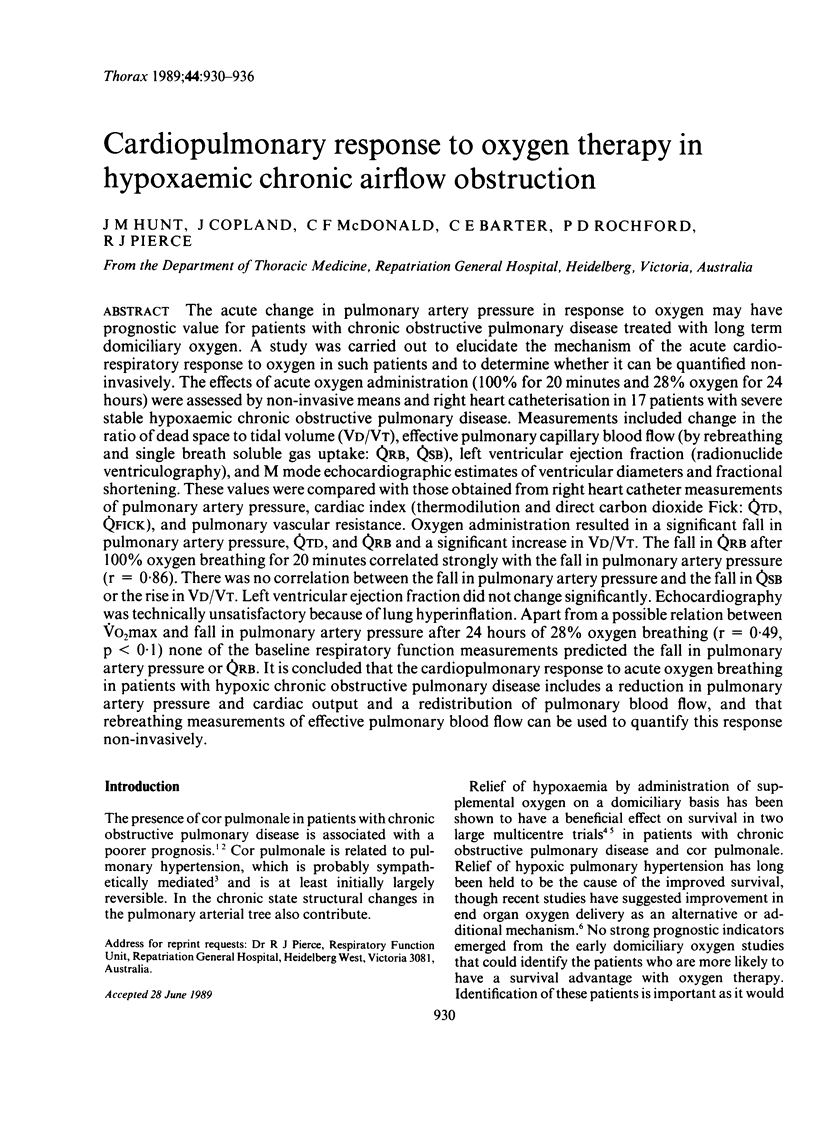
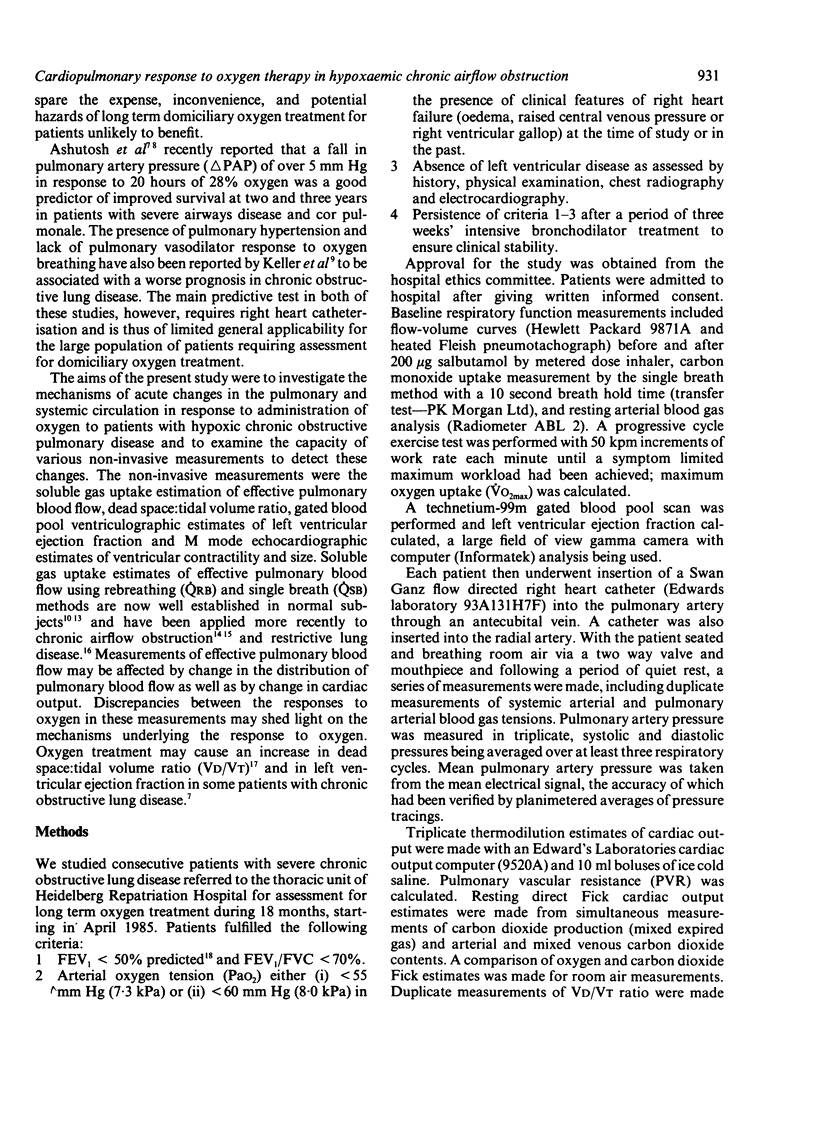
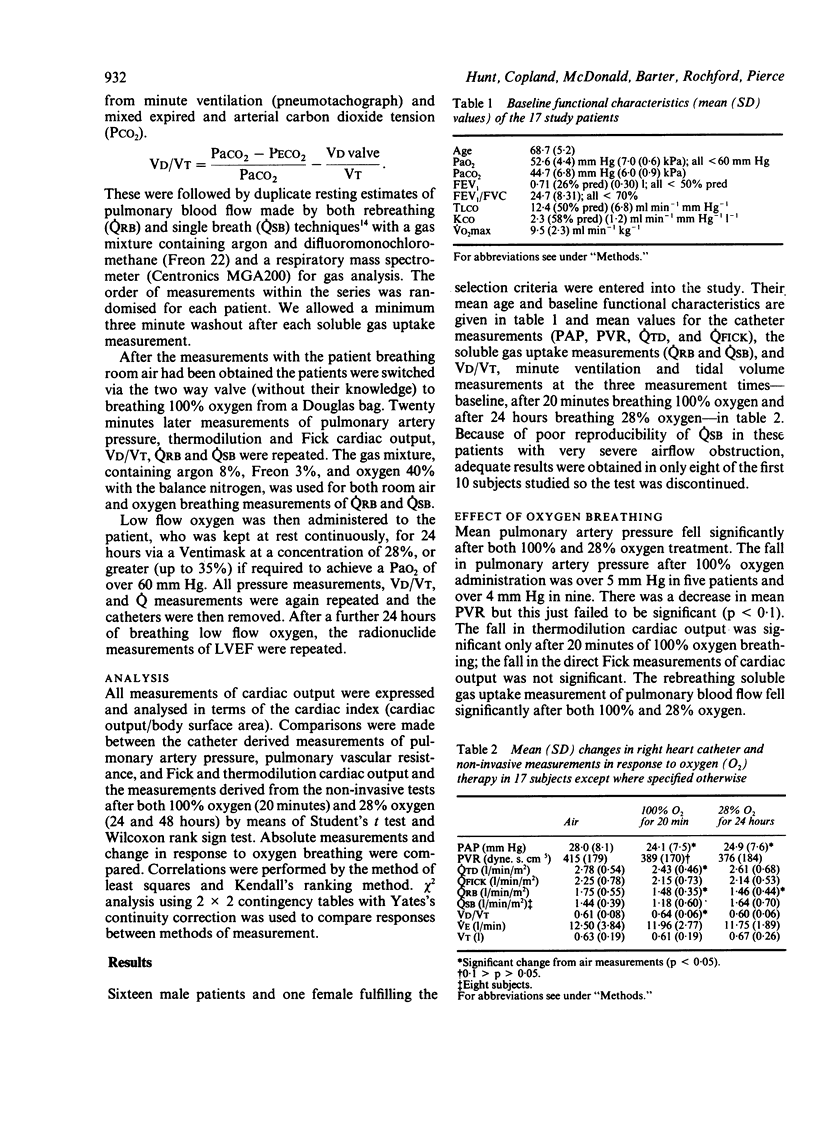

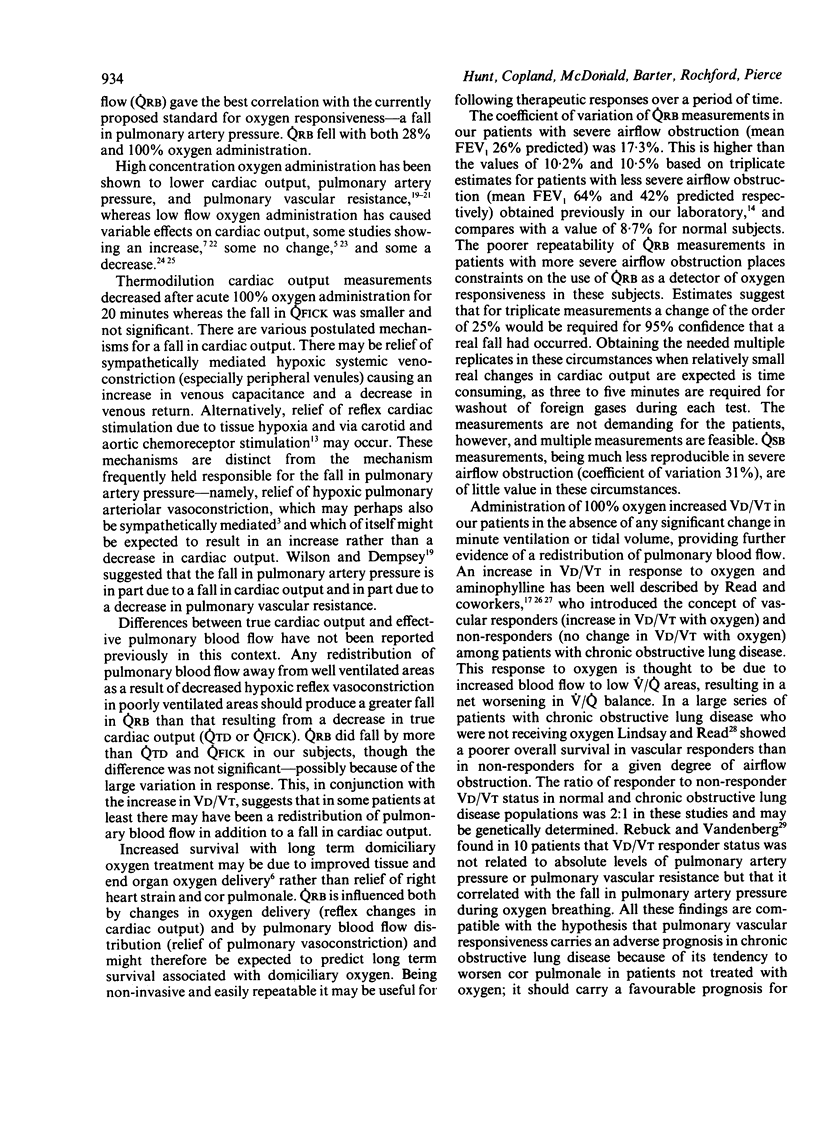
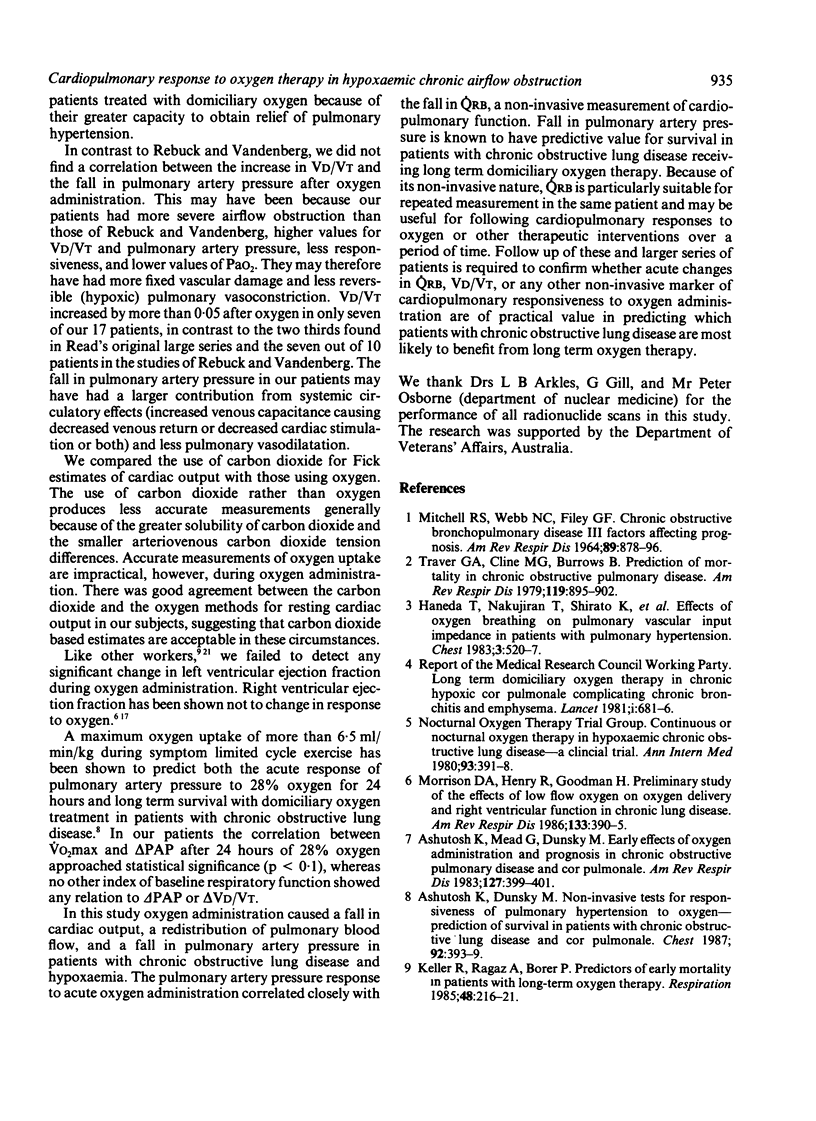
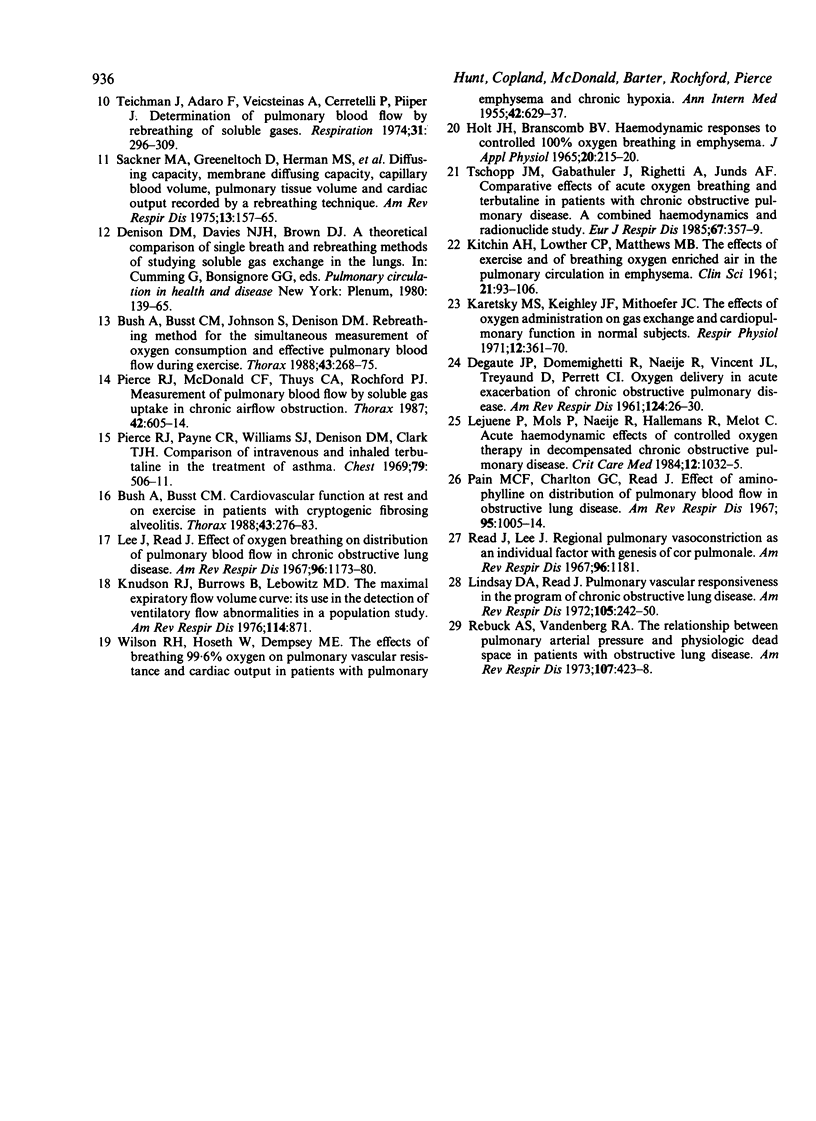
Selected References
These references are in PubMed. This may not be the complete list of references from this article.
- Ashutosh K., Dunsky M. Noninvasive tests for responsiveness of pulmonary hypertension to oxygen. Prediction of survival in patients with chronic obstructive lung disease and cor pulmonale. Chest. 1987 Sep;92(3):393–399. doi: 10.1378/chest.92.3.393. [DOI] [PubMed] [Google Scholar]
- Ashutosh K., Mead G., Dunsky M. Early effects of oxygen administration and prognosis in chronic obstructive pulmonary disease and cor pulmonale. Am Rev Respir Dis. 1983 Apr;127(4):399–404. doi: 10.1164/arrd.1983.127.4.399. [DOI] [PubMed] [Google Scholar]
- Bush A., Busst C. M. Cardiovascular function at rest and on exercise in patients with cryptogenic fibrosing alveolitis. Thorax. 1988 Apr;43(4):276–283. doi: 10.1136/thx.43.4.276. [DOI] [PMC free article] [PubMed] [Google Scholar]
- Bush A., Busst C. M., Johnson S., Denison D. M. Rebreathing method for the simultaneous measurement of oxygen consumption and effective pulmonary blood flow during exercise. Thorax. 1988 Apr;43(4):268–275. doi: 10.1136/thx.43.4.268. [DOI] [PMC free article] [PubMed] [Google Scholar]
- DeGaute J. P., Domenighetti G., Naeije R., Vincent J. L., Treyvaud D., Perret C. Oxygen delivery in acute exacerbation of chronic obstructive pulmonary disease. Effects of controlled oxygen therapy. Am Rev Respir Dis. 1981 Jul;124(1):26–30. doi: 10.1164/arrd.1981.124.1.26. [DOI] [PubMed] [Google Scholar]
- Haneda T., Nakajima T., Shirato K., Onodera S., Takishima T. Effects of oxygen breathing on pulmonary vascular input impedance in patients with pulmonary hypertension. Chest. 1983 Mar;83(3):520–527. doi: 10.1378/chest.83.3.520. [DOI] [PubMed] [Google Scholar]
- KITCHIN A. H., LOWTHER C. P., MATTHEWS M. B. The effects of exercise and of breathing oxygen-enriched air on the pulmonary circulation in emphysema. Clin Sci. 1961 Aug;21:93–106. [PubMed] [Google Scholar]
- Karetzky M. S., Keighley J. F., Mithoefer J. C. The effect of oxygen administration on gas exchange and cardiopulmonary function in normal subjects. Respir Physiol. 1971 Aug;12(3):361–370. doi: 10.1016/0034-5687(71)90076-4. [DOI] [PubMed] [Google Scholar]
- Keller R., Ragaz A., Borer P. Predictors for early mortality in patients with long-term oxygen home therapy. Respiration. 1985;48(3):216–221. doi: 10.1159/000194832. [DOI] [PubMed] [Google Scholar]
- Knudson R. J., Burrows B., Lebowitz M. D. The maximal expiratory flow-volume curve: its use in the detection of ventilatory abnormalities in a population study. Am Rev Respir Dis. 1976 Nov;114(5):871–879. doi: 10.1164/arrd.1976.114.5.871. [DOI] [PubMed] [Google Scholar]
- Lee J., Read J. Effect of oxygen breathing on distribution of pulmonary blood flow in chronic obstructive lung disease. Am Rev Respir Dis. 1967 Dec;96(6):1173–1180. doi: 10.1164/arrd.1967.96.6.1173. [DOI] [PubMed] [Google Scholar]
- Lejeune P., Mols P., Naeije R., Hallemans R., Melot C. Acute hemodynamic effects of controlled oxygen therapy in decompensated chronic obstructive pulmonary disease. Crit Care Med. 1984 Dec;12(12):1032–1035. doi: 10.1097/00003246-198412000-00006. [DOI] [PubMed] [Google Scholar]
- Lindsay D. A., Read J. Pulmonary vascular responsiveness in the prognosis of chronic obstructive lung disease. Am Rev Respir Dis. 1972 Feb;105(2):242–250. doi: 10.1164/arrd.1972.105.2.242. [DOI] [PubMed] [Google Scholar]
- MITCHELL R. S., WEBB N. C., FILLEY G. F. CHRONIC OBSTRUCTIVE BRONCHOPULMONARY DISEASE. III. FACTORS INFLUENCING PROGNOSIS. Am Rev Respir Dis. 1964 Jun;89:878–896. doi: 10.1164/arrd.1964.89.6.878. [DOI] [PubMed] [Google Scholar]
- Morrison D. A., Henry R., Goldman S. Preliminary study of the effects of low flow oxygen on oxygen delivery and right ventricular function in chronic lung disease. Am Rev Respir Dis. 1986 Mar;133(3):390–395. doi: 10.1164/arrd.1986.133.3.390. [DOI] [PubMed] [Google Scholar]
- Pain M. C., Charlton G. C., Read J. Effect of intravenous aminophylline on distribution of pulmonary blood flow in obstructive lung disease. Am Rev Respir Dis. 1967 Jun;95(6):1005–1014. doi: 10.1164/arrd.1967.95.6.1005. [DOI] [PubMed] [Google Scholar]
- Pierce R. J., Payne C. R., Williams S. J., Denison D. M., Clark T. J. Comparison of intravenous and inhaled terbutaline in the treatment of asthma. Chest. 1981 May;79(5):506–511. doi: 10.1378/chest.79.5.506. [DOI] [PubMed] [Google Scholar]
- Read J., Lee J. Regional pulmonary vasoconstriction as an individual factor in the genesis of cor pulmonale. Am Rev Respir Dis. 1967 Dec;96(6):1181–1189. doi: 10.1164/arrd.1967.96.6.1181. [DOI] [PubMed] [Google Scholar]
- Rebuck A. S., Vandenberg R. A. The relationship between pulmonary arterial pressure and physiologic dead space in patients with obstructive lung disease. Am Rev Respir Dis. 1973 Mar;107(3):423–428. doi: 10.1164/arrd.1973.107.3.423. [DOI] [PubMed] [Google Scholar]
- Sackner M. A., Greeneltch D., Heiman M. S., Epstein S., Atkins N. Diffusing capacity, membrane diffusing capacity, capillary blood volume, pulmonary tissue volume, and cardiac output measured by a rebreathing technique. Am Rev Respir Dis. 1975 Feb;111(2):157–165. doi: 10.1164/arrd.1975.111.2.157. [DOI] [PubMed] [Google Scholar]
- Teichmann J., Adaro F., Veicsteinas A., Cerretelli P., Piiper J. Determination of pulmonary blood flow by rebreathing of soluble inert gases. Respiration. 1974;31(4):296–309. doi: 10.1159/000193590. [DOI] [PubMed] [Google Scholar]
- Traver G. A., Cline M. G., Burrows B. Predictors of mortality in chronic obstructive pulmonary disease. A 15-year follow-up study. Am Rev Respir Dis. 1979 Jun;119(6):895–902. doi: 10.1164/arrd.1979.119.6.895. [DOI] [PubMed] [Google Scholar]
- WILSON R. H., HOSETH W., DEMPSEY M. E. The effects of breathing 99.6% oxygen on pulmonary vascular resistance and cardiac output in patients with pulmonary emphysema and chronic hypoxia. Ann Intern Med. 1955 Mar;42(3):629–637. doi: 10.7326/0003-4819-42-3-629. [DOI] [PubMed] [Google Scholar]


